Mnemosyne Atlas 23
“E quindi uscimmo a riveder le stelle”: cosmo e destino a Padova e nella Divina Commedia
Dalle pagine miniate della tradizione arabo-meridionale, gli dèi planetari approdano al grande ‘libro’ astrologico del Salone dei Mesi di Padova. Una “divina commedia” in cui le sfere celesti, legate alle arti e alle inclinazioni dell’uomo, condizionano come demoni astrali i propri ‘figli’ (rappresentazione dei mestieri).
“And thence we came forth to see again the stars": cosmos and destiny in Padua and in the Divine Comedy
From the illuminated pages of the southern Arabic tradition, planetary gods reach the great astrological frescoed 'book' of the ‘Hall of the Months’ in Palazzo della Ragione in Padua. A ‘divine comedy’ in which the celestial spheres, linked to man’s inclinations, influence their 'children' (representing crafts) in the guise of astral daemons.
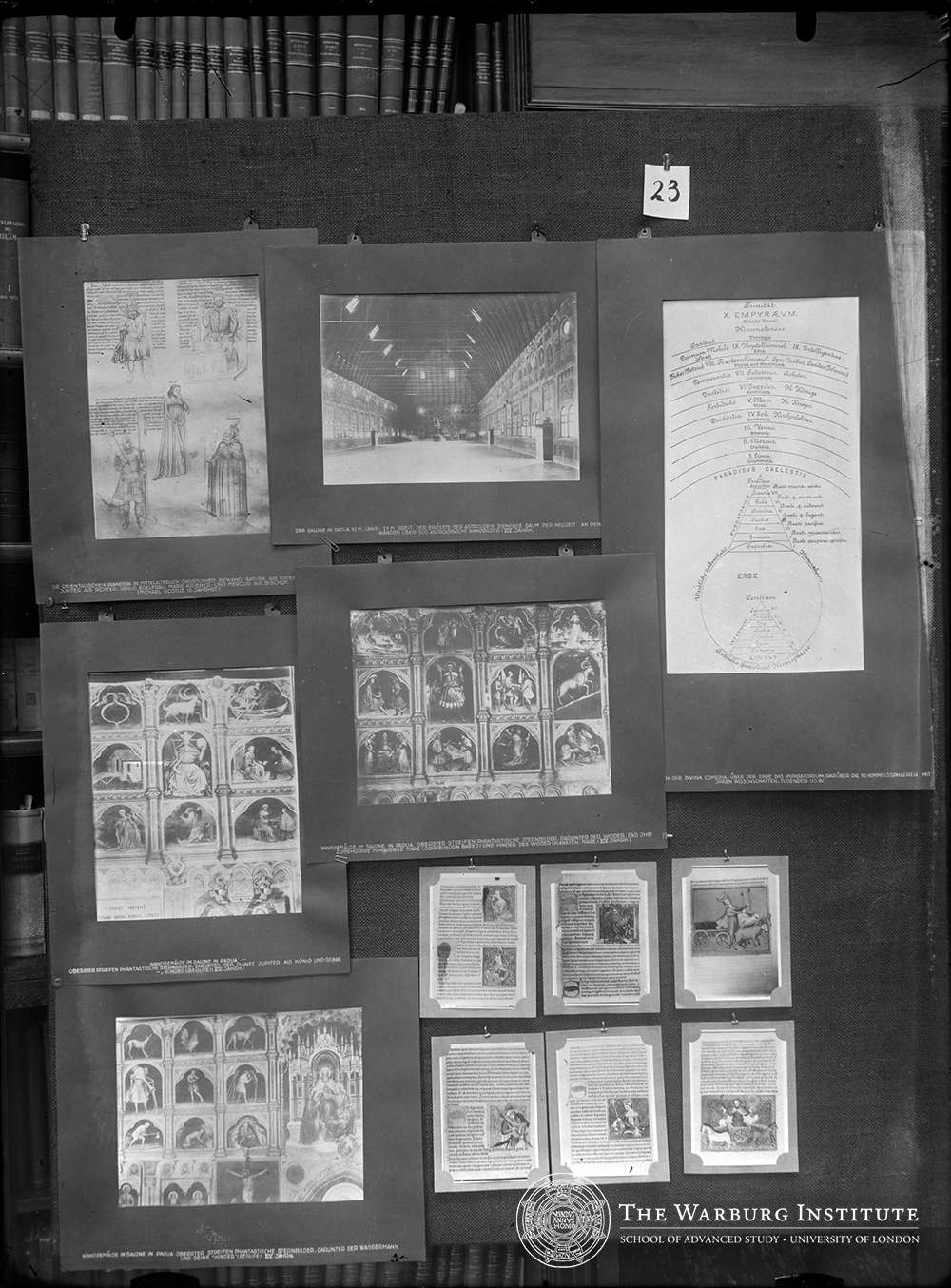
AAppunti di Aby Warburg (1929)
Padua. Scotus
Padova, Scoto.
Appunti di Aby Warburg e collaboratori (1929)
Süditalienisch-arabische Antike. Salone als Riesen-Buchseite zum Zwecke der Schicksalsbestimmung. Dante-Schema. (Fehlt Angeli!).
Antico in versione arabo-suditalica. Il Salone [dei mesi] come immensa pagina di un libro ai fini della determinazione del destino. Schema di Dante (manca: Angeli!).
Appunti di Gertrud Bing (1940 ca)
Unmittelbare Übertragung nach Mittel-Europa. Scotus’ Planeten gleichzeitig mit Toledo, Salone in Padua riesenhafter Wahrsage-Kalender. Mars – Widder, Jupiter, Wassermann mit Berufen. Weltbild des Dante. Planeten Wenzel hs (Scotus). Antike Dämonen in Christlichem Gewande.
Trasmissione diretta verso il centro Europa. I pianeti di Scotus allo stesso tempo a Toledo, Salone di Padova come gigantesco calendario divinatorio. Marte – Ariete, Giove, Acquario con i mestieri. Visione del mondo di Dante. Pianeti del manoscritto di Venceslao (Scotus). Demoni antichi in veste cristiana.
Letture di approfondimento
Notes by Aby Warburg (1929)
Padua. Scotus
Padua, Scotus.
Notes by Aby Warburg and coll. (1929)
Süditalienisch-arabische Antike. Salone als Riesen-Buchseite zum Zwecke der Schicksalsbestimmung. Dante-Schema. (Fehlt Angeli!).
Southern Italian-Arab Antiquity. The Salone dei Mesi as the huge page of a book intended to determine fate. Dante schema. (Angeli is missing!).
Notes by Gertrud Bing (ca. 1940)
Unmittelbare Übertragung nach Mittel-Europa. Scotus’ Planeten gleichzeitig mit Toledo, Salone in Padua riesenhafter Wahrsage-Kalender. Mars – Widder, Jupiter, Wassermann mit Berufen. Weltbild des Dante. Planeten Wenzel hs (Scotus). Antike Dämonen in Christlichem Gewande.
Direct transmission to central Europe. Scotus’ planets at the same time in Toledo, Salon of Padua as a giant divinatory calendar. Mars – Aries, Jupiter, Aquarius with the trades. Dante’s world view. Planets of Wenceslas (Scotus). Ancient demons in Christian guise.
Further Readings

1. I pianeti orientali in veste cristiana medioevale: Saturno guerriero, Giove giudice, Venere nobildonna, Marte guerriero e Mercurio vescovo (Michael Scotus, XIII sec.) [didascalia della KBW], da Michael Scotus, Liber Introductorius, 1228, manoscritto padovano del 1340 ca., Cod. lat. 10268, fol. 85r (München, Bayerische Staatsbibliothek).
2. Il Salone di Padova: 82 metri di lunghezza, 27 metri di larghezza. Il più grande spazio dedicato all'astrologia nell'età moderna. Alle pareti oltre 300 dipinti murali astrologici (sec. XIV) [didascalia della KBW], veduta dell'interno.
3. Nella Divina Commedia, il purgatorio sopra la terra. Su di esso, le dieci sfere celesti [con] le rispettive scienze, virtù ecc. [didascalia della KBW], illustrazione schematica della descrizione dantesca del mondo nella Divina Commedia, London, The Warburg Institute.
4. Salone di Padova, pittura murale. Nella fascia superiore: costellazioni fantastiche, tra esse l'Ariete, il relativo mese di Marte (che suona il doppio corno) e i figli del pianeta dell'Ariete, Marte (sec. XIV) [didascalia della KBW], affreschi.
5. Salone di Padova, pittura murale. Nella fascia superiore: costellazioni fantastiche, tra esse il pianeta Giove in aspetto di re e i suoi "figli" (professioni), sec. XIV [didascalia della KBW], affreschi.
6. Salone di Padova, pittura murale. Nella fascia superiore: costellazioni fantastiche, tra esse l'Acquario e i suoi "figli" (professioni), sec. XIV [didascalia della KBW], affreschi.
7. Miniature da un manoscritto di Re Venceslao IV di Boemia del Liber Introductorius di Michael Scotus, Venere (come bella vergine con fiori) e Mercurio (come uomo del libro), Praga 1392-1394, Cod. Vindob. 2352, fol. 28v, Wien, Österreichische Nationalbibliothek.
8. Miniature da un manoscritto di Re Venceslao IV di Boemia del Liber Introductorius di Michael Scotus, Marte, Praga 1392-1394, Cod. Vindob. 2352, fol. 28r, Wien, Österreichische Nationalbibliothek.
9. Miniature da un manoscritto di Re Venceslao IV di Boemia del Liber Introductorius di Michael Scotus, Saturno (in veste di guerriero medievale), Praga 1392-1394, Cod. Vindob. 2352, fol. 27r, Wien, Österreichische Nationalbibliothek.
10. Miniature da un manoscritto di Re Venceslao IV di Boemia del Liber Introductorius di Michael Scotus, Giove (come giudice in veste da giurista), Praga 1392-1394, Cod. Vindob. 2352, fol. 27v, Wien, Österreichische Nationalbibliothek.
11. Miniature da un manoscritto di Re Venceslao IV di Boemia del Liber Introductorius di Michael Scotus, Luna, Praga 1392-1394, Cod. Vindob. 2352, fol. 31v, Wien, Österreichische Nationalbibliothek.
12. Miniature da un manoscritto di Re Venceslao IV di Boemia del Liber Introductorius di Michael Scotus, Sole, Praga 1392-1394, Cod. Vindob. 2352, fol. 29r, Wien, Österreichische Nationalbibliothek.
1. The oriental planets in christian-medieval dress: Saturn as a warrior, Jupiter as a judge, Venus as a Lady, Mars as a warrior, Mercury as a bishop (Michael Scotus, XIII sec.) [caption of the KBW], from Michael Scotus, Liber Introductorius, 1228, manuscript from Padua, 1340 ca., Cod. lat. 10268, fol. 85r (München, Bayerische Staatsbibliothek).
2. The Padua Salone: 82 meters long, 27 meters large. The biggest space dedicated to astrology into modern ages. At the walls more than 300 mural paints (XIV century) [caption of the KBW], inside view.
3. From the Divine Comedy, the purgatory over the earth. Over it the ten celestial spheres with the respective sciences, virtues, etc. [caption of the KBW], schematic picture of the description of the World into the Divine Comedy, London, The Warburg Institute.
4. The Padua Salone, mural paint. Upper band: imaginary constellations, among them Aries, the relative month of Mars (who play double horn) and the sons of the planet of Aries, Mars (XIV century) [caption della of the KBW], frescoes.
5. The Padua Salone, mural paint. Upper band: imaginary constellations, among them Jupiter as a king and his 'sons' (professions), XIV century [caption della of the KBW], frescoes.
6. The Padua Salone, mural paint. Upper band: imaginary constellations, among them Aquarius aand his 'sons' (professions), XIV century [caption della of the KBW], frescoes.
7. Illuminations from a manuscript of Wenceslaus IV of Bohemia of Michael Scotus' Liber Introductorius, Venus (like a pretty virgin with flowers) and Mercury (like a man of the book), Prague, 1392-1394, Cod. Vindob. 2352, fol. 28v, Wien, Österreichische Nationalbibliothek.
8. Illuminations from a manuscript of Wenceslaus IV of Bohemia of Michael Scotus' Liber Introductorius, Mars, Prague, 1392-1394, Cod. Vindob. 2352, fol. 28r, Wien, Österreichische Nationalbibliothek.
9. Illuminations from a manuscript of Wenceslaus IV of Bohemia of Michael Scotus' Liber Introductorius, Saturn (like a medieval warrior), Prague, 1392-1394, Cod. Vindob. 2352, fol. 27r, Wien, Österreichische Nationalbibliothek.
10. Illuminations from a manuscript of Wenceslaus IV of Bohemia of Michael Scotus' Liber Introductorius, Jupiter (as a judge with lawyer dress), Prague, 1392-1394, Cod. Vindob. 2352, fol. 28v, Wien, Österreichische Nationalbibliothek.
11. Illuminations from a manuscript of Wenceslaus IV of Bohemia of Michael Scotus' Liber Introductorius, Moon, Prague, 1392-1394, Cod. Vindob. 2352, fol. 31v, Wien, Österreichische Nationalbibliothek.
12. Illuminations from a manuscript of Wenceslaus IV of Bohemia of Michael Scotus' Liber Introductorius, Sun, Prague, 1392-1394, Cod. Vindob. 2352, fol. 29r, Wien, Österreichische Nationalbibliothek.


23_1 | I pianeti orientali in veste cristiana medioevale: Saturno guerriero, Giove giudice, Venere nobildonna, Marte guerriero e Mercurio vescovo (Michael Scotus, XIII sec.) [didascalia della KBW], da Michael Scotus, Liber Introductorius, 1228, manoscritto padovano del 1340 ca., Cod. lat. 10268, fol. 85r (München, Bayerische Staatsbibliothek)
23_1 | The oriental planets in christian-medieval dress: Saturn as a warrior, Jupiter as a judge, Venus as a Lady, Mars as a warrior, Mercury as a bishop (Michael Scotus, XIII sec.) [caption of the KBW], from Michael Scotus, Liber Introductorius, 1228, manuscript from Padua, 1340 ca., Cod. lat. 10268, fol. 85r (München, Bayerische Staatsbibliothek)
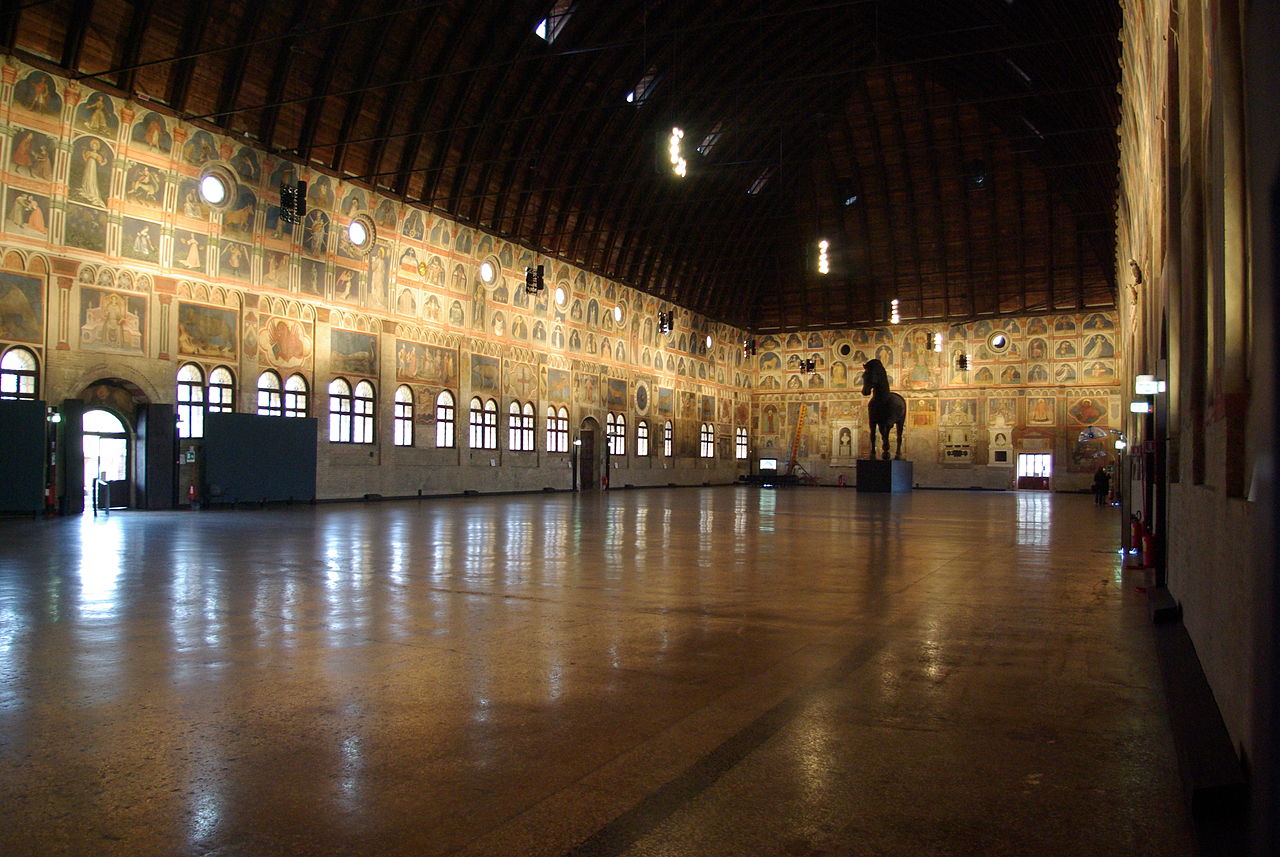
23_2 | Il Salone di Padova: 82 metri di lunghezza, 27 metri di larghezza. Il più grande spazio dedicato all'astrologia nell'età moderna. Alle pareti oltre 300 dipinti murali astrologici (sec. XIV) [didascalia della KBW], veduta dell'interno
23_2 | The Padua Salone: 82 meters long, 27 meters large. The biggest space dedicated to astrology into modern ages. At the walls more than 300 mural paints (XIV century) [caption of the KBW], inside view
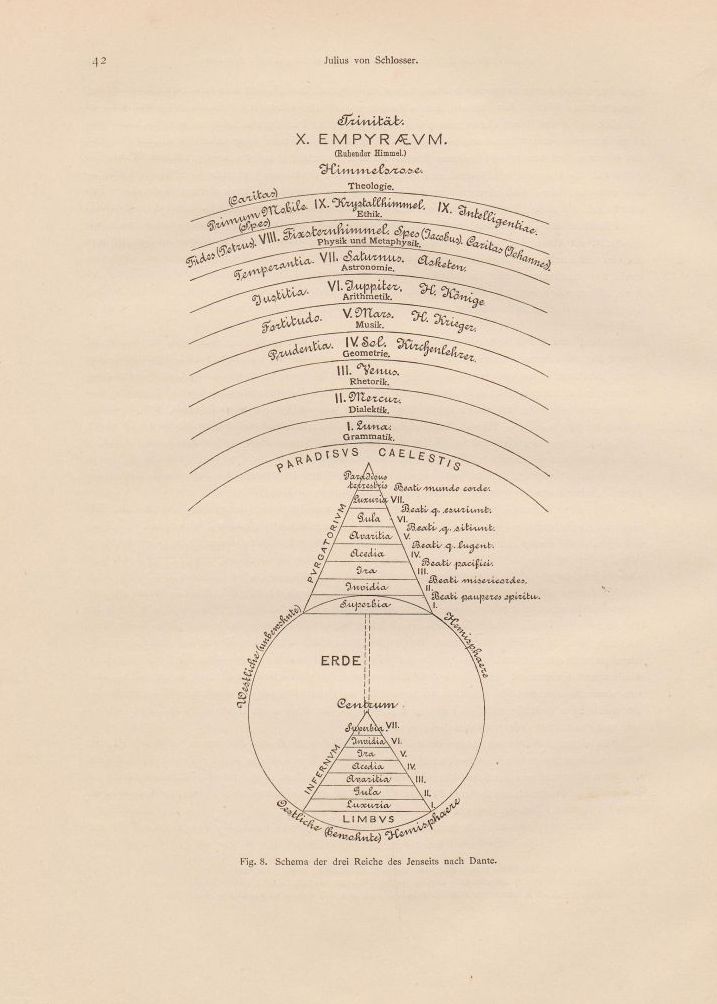
23_3 | Nella Divina Commedia, il purgatorio sopra la terra. Su di esso, le dieci sfere celesti [con] le rispettive scienze, virtù ecc. [didascalia della KBW], illustrazione schematica della descrizione dantesca del mondo nella Divina Commedia, London, The Warburg Institute
23_3 | From the Divine Comedy, the purgatory over the earth. Over it the ten celestial spheres with the respective sciences, virtues, etc. [caption of the KBW], schematic picture of the description of the World into the Divine Comedy, London, The Warburg Institute
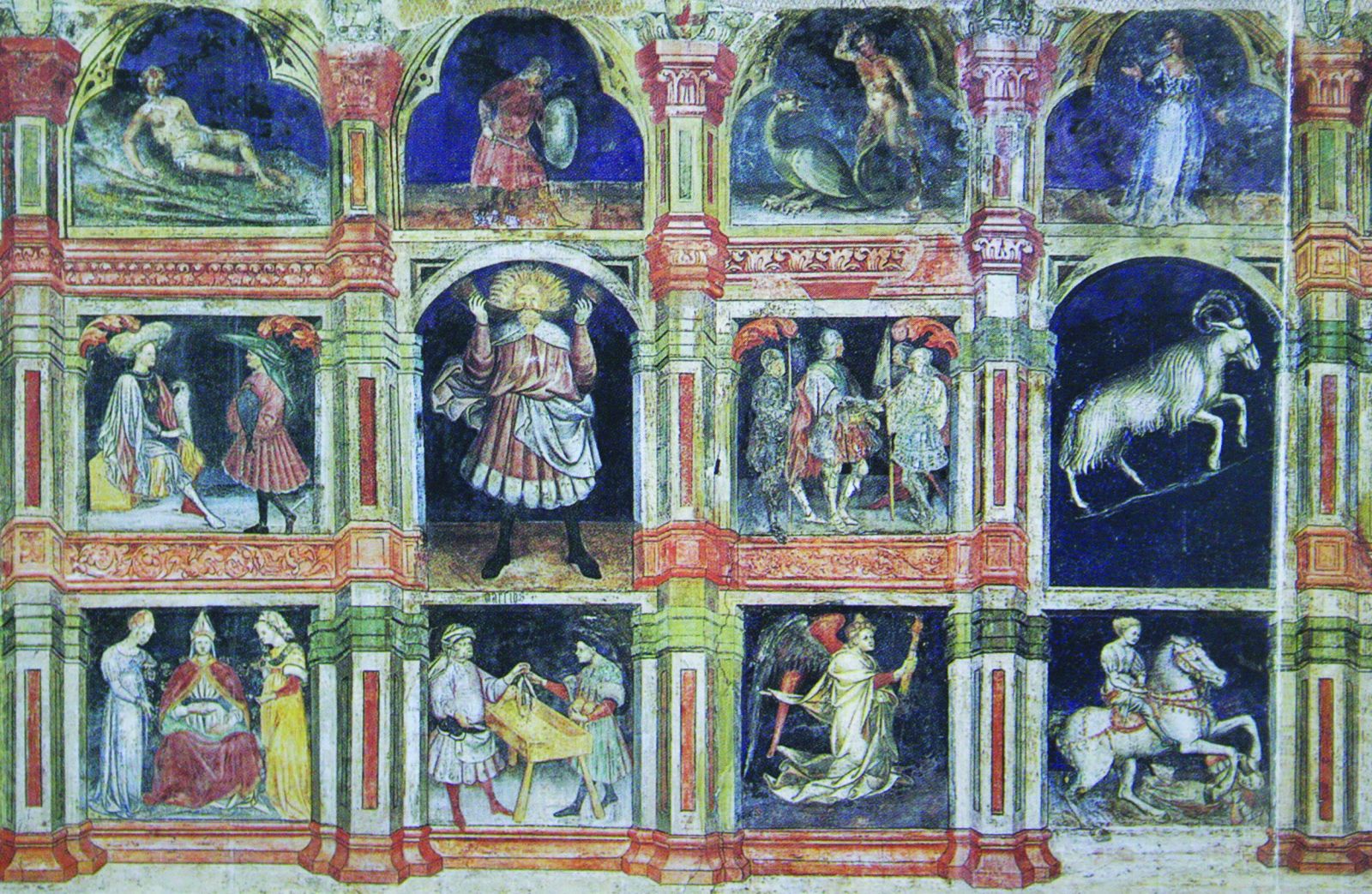
23_4 | Salone di Padova, pittura murale. Nella fascia superiore: costellazioni fantastiche, tra esse l'Ariete, il relativo mese di Marte (che suona il doppio corno) e i figli del pianeta dell'Ariete, Marte (sec. XIV) [didascalia della KBW], affreschi
23_4 | The Padua Salone, mural paint. Upper band: imaginary constellations, among them Aries, the relative month of Mars (who play double horn) and the sons of the planet of Aries, Mars (XIV century) [caption della of the KBW], frescoes

23_5 | Salone di Padova, pittura murale. Nella fascia superiore: costellazioni fantastiche, tra esse il pianeta Giove in aspetto di re e i suoi "figli" (professioni), sec. XIV [didascalia della KBW], affreschi
23_5 | The Padua Salone, mural paint. Upper band: imaginary constellations, among them Jupiter as a king and his 'sons' (professions), XIV century [caption della of the KBW], frescoes

23_6 | Salone di Padova, pittura murale. Nella fascia superiore: costellazioni fantastiche, tra esse l'Acquario e i suoi "figli" (professioni), sec. XIV [didascalia della KBW], affreschi
23_6 | The Padua Salone, mural paint. Upper band: imaginary constellations, among them Aquarius aand his 'sons' (professions), XIV century [caption della of the KBW], frescoes
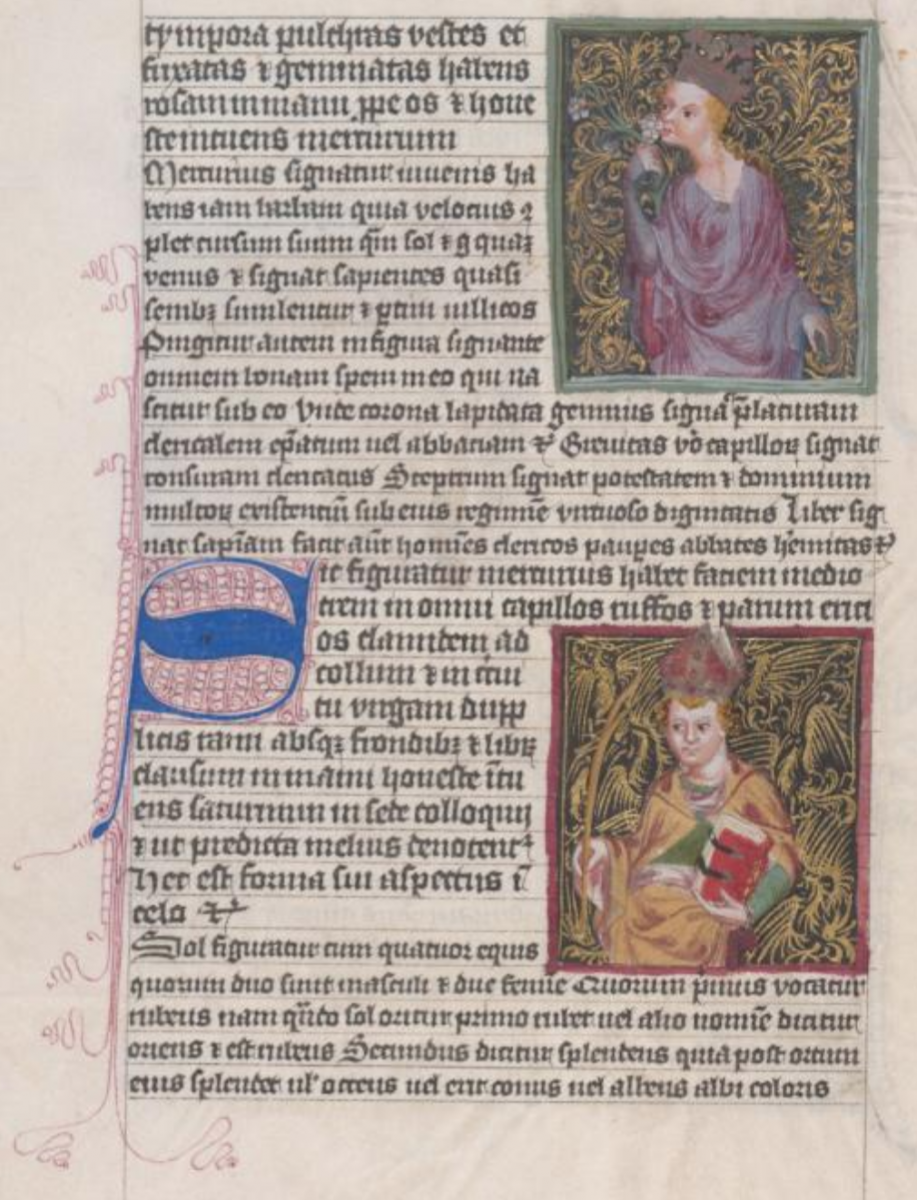
23_7 | Miniature da un manoscritto di Re Venceslao IV di Boemia del Liber Introductorius di Michael Scotus, Venere (come bella vergine con fiori) e Mercurio (come uomo del libro), Praga 1392-1394, Cod. Vindob. 2352, fol. 28v, Wien, Österreichische Nationalbibliothek
23_7 | Illuminations from a manuscript of Wenceslaus IV of Bohemia of Michael Scotus' Liber Introductorius, Venus (like a pretty virgin with flowers) and Mercury (like a man of the book), Prague, 1392-1394, Cod. Vindob. 2352, fol. 28v, Wien, Österreichische Nationalbibliothek
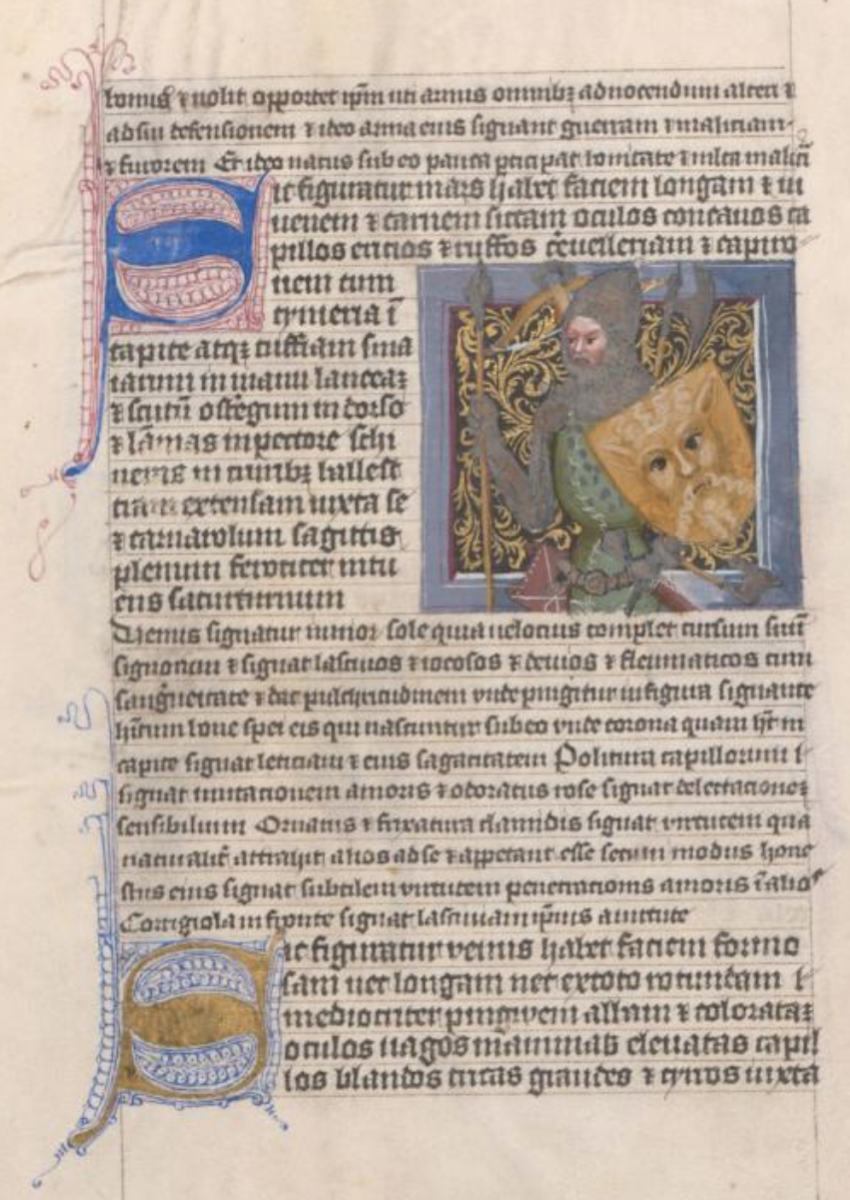
23_8 | Miniature da un manoscritto di Re Venceslao IV di Boemia del Liber Introductorius di Michael Scotus, Marte, Praga 1392-1394, Cod. Vindob. 2352, fol. 28r, Wien, Österreichische Nationalbibliothek
23_8 | Illuminations from a manuscript of Wenceslaus IV of Bohemia of Michael Scotus' Liber Introductorius, Mars, Prague, 1392-1394, Cod. Vindob. 2352, fol. 28r, Wien, Österreichische Nationalbibliothek
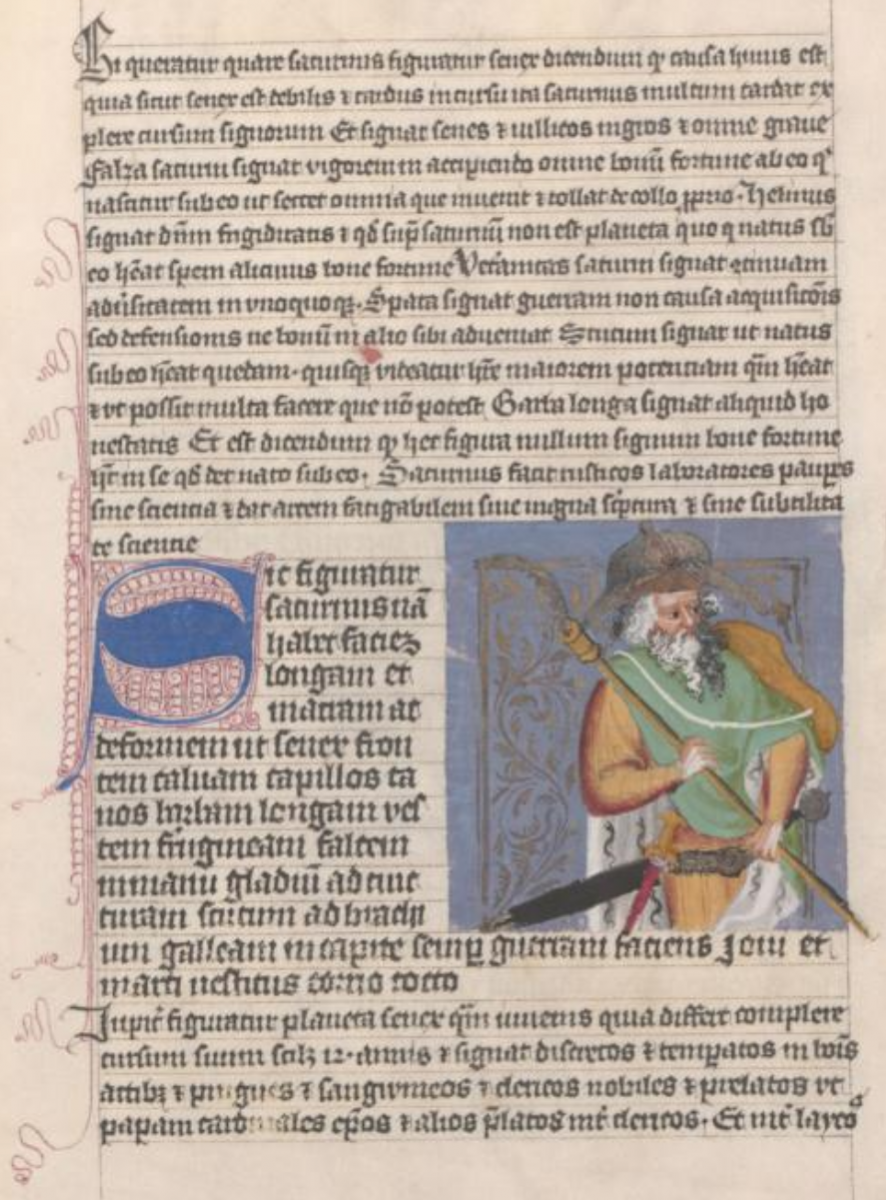
23_9 | Miniature da un manoscritto di Re Venceslao IV di Boemia del Liber Introductorius di Michael Scotus, Saturno (in veste di guerriero medievale), Praga 1392-1394, Cod. Vindob. 2352, fol. 27r, Wien, Österreichische Nationalbibliothek
23_9 | Illuminations from a manuscript of Wenceslaus IV of Bohemia of Michael Scotus' Liber Introductorius, Saturn (like a medieval warrior), Prague, 1392-1394, Cod. Vindob. 2352, fol. 27r, Wien, Österreichische Nationalbibliothek
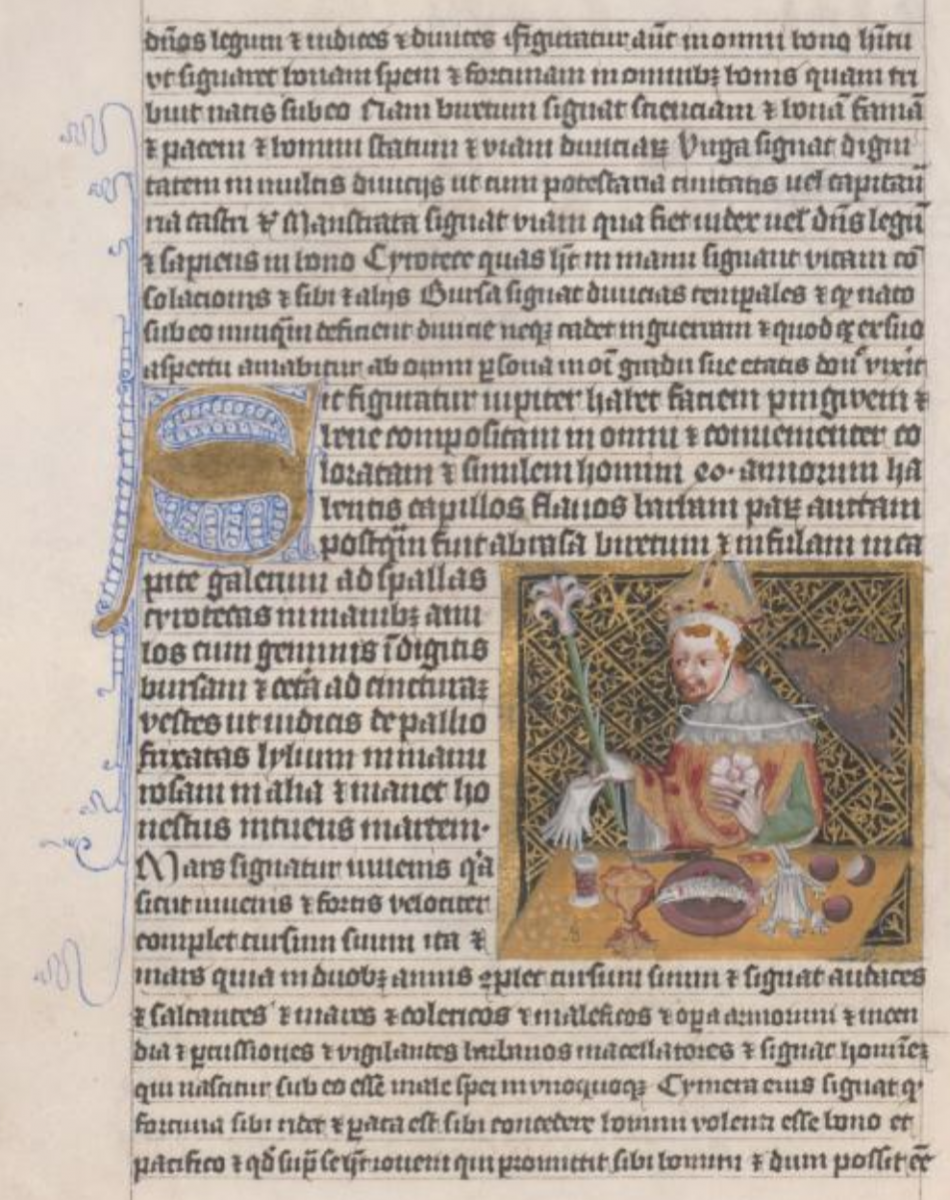
23_10 | Miniature da un manoscritto di Re Venceslao IV di Boemia del Liber Introductorius di Michael Scotus, Giove (come giudice in veste da giurista), Praga 1392-1394, Cod. Vindob. 2352, fol. 27v, Wien, Österreichische Nationalbibliothek
23_10 | Illuminations from a manuscript of Wenceslaus IV of Bohemia of Michael Scotus' Liber Introductorius, Jupiter (as a judge with lawyer dress), Prague, 1392-1394, Cod. Vindob. 2352, fol. 28v, Wien, Österreichische Nationalbibliothek

23_11 | Miniature da un manoscritto di Re Venceslao IV di Boemia del Liber Introductorius di Michael Scotus, Luna, Praga 1392-1394, Cod. Vindob. 2352, fol. 31v, Wien, Österreichische Nationalbibliothek
23_11 | Illuminations from a manuscript of Wenceslaus IV of Bohemia of Michael Scotus' Liber Introductorius, Moon, Prague, 1392-1394, Cod. Vindob. 2352, fol. 31v, Wien, Österreichische Nationalbibliothek

23_12 | Miniature da un manoscritto di Re Venceslao IV di Boemia del Liber Introductorius di Michael Scotus, Sole, Praga 1392-1394, Cod. Vindob. 2352, fol. 29r, Wien, Österreichische Nationalbibliothek
23_12 | Illuminations from a manuscript of Wenceslaus IV of Bohemia of Michael Scotus' Liber Introductorius, Sun, Prague, 1392-1394, Cod. Vindob. 2352, fol. 29r, Wien, Österreichische Nationalbibliothek

